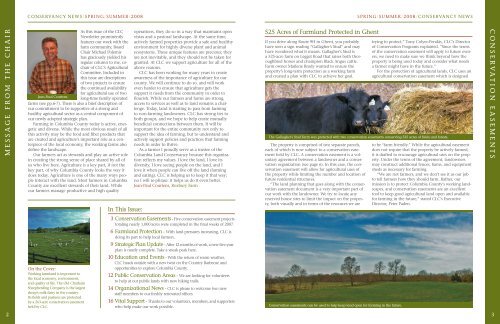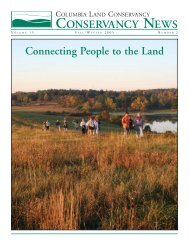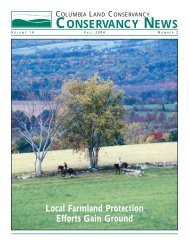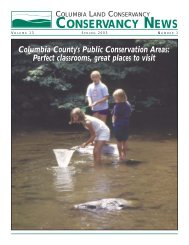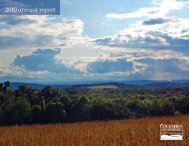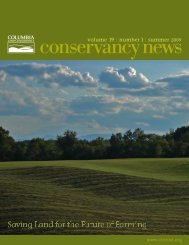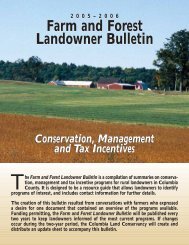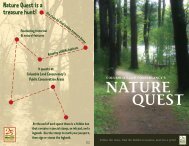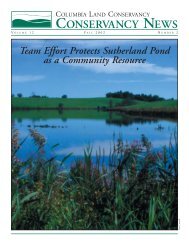Spring 2008 - Columbia Land Conservancy
Spring 2008 - Columbia Land Conservancy
Spring 2008 - Columbia Land Conservancy
You also want an ePaper? Increase the reach of your titles
YUMPU automatically turns print PDFs into web optimized ePapers that Google loves.
CONSERVANCY NEWS/SPRING/SUMMER/<strong>2008</strong><br />
SPRING/SUMMER/<strong>2008</strong>/CONSERVANCY NEWS<br />
M E S S A G E F R O M T H E C H A I R<br />
As this issue of the CLC<br />
Newsletter prominently<br />
features our work with the<br />
farm community, Board<br />
Chair Michael Polemis<br />
has graciously yielded his<br />
regular column to me, cochair<br />
of CLC’s Agricultural<br />
Committee. Included in<br />
this issue are descriptions<br />
of two projects to ensure<br />
the continued availability<br />
for agricultural use of two<br />
Jean-Paul Courtens<br />
long-time family operated<br />
farms (see pp.6-7). There is also a brief description of<br />
our commitment to be supportive of a strong and<br />
healthy agricultural sector as a central component of<br />
our newly adopted strategic plan.<br />
Farming in <strong>Columbia</strong> County today is active, energetic<br />
and diverse. While the most obvious result of all<br />
this activity may be the food and fiber products that<br />
are created and agriculture’s important role as a centerpiece<br />
of the local economy, the working farms also<br />
define the landscape.<br />
Our farmers act as stewards and play an active role<br />
in creating the strong sense of place shared by all of<br />
us who live here. Agriculture is a key part, if not the<br />
key part, of why <strong>Columbia</strong> County looks the way it<br />
does today. Agriculture is one of the many ways people<br />
interact with the land. Most farmers in <strong>Columbia</strong><br />
County are excellent stewards of their land. While<br />
our farmers manage productive and high quality<br />
In This Issue:<br />
operations, they do so in a way that maintains open<br />
vistas and a pastoral landscape. At the same time,<br />
actively farmed properties provide a safe and healthy<br />
environment for highly diverse plant and animal<br />
ecosystems. These unique features are precious; they<br />
are not inevitable, and they should not be taken for<br />
granted. At CLC we support agriculture for all of the<br />
above reasons.<br />
CLC has been working for many years to create<br />
awareness of the importance of agriculture for our<br />
county. We will continue to do so, and will work<br />
even harder to ensure that agriculture gets the<br />
support it needs from the community in order to<br />
flourish. While our farmers and farms are strong,<br />
access to services as well as to land remains a challenge.<br />
Today, land is starting to pass from farming<br />
to non-farming landowners. CLC has strong ties to<br />
both groups, and we hope to help create mutually<br />
beneficial connections between them. It will be<br />
important for the entire community not only to<br />
support the idea of farming, but to understand and<br />
actively support policies and practices that farming<br />
needs in order to thrive.<br />
As a farmer I proudly serve as a trustee of the<br />
<strong>Columbia</strong> <strong>Land</strong> <strong>Conservancy</strong> because this organization<br />
reflects my values. I love the land, I love its<br />
diversity, I love seeing people on the land, and I<br />
love it when people can live off the land (farming<br />
and eating). CLC is helping us to keep it that way;<br />
no I will re-phrase: it helps us do it even better.<br />
Jean-Paul Courtens, Roxbury Farm<br />
525 Acres of Farmland Protected in Ghent<br />
If you drive along Route 9H in Ghent, you probably<br />
have seen a sign reading “Gallagher’s Stud” and may<br />
have wondered what it means. Gallagher’s Stud is<br />
a 525-acre farm on Legget Road that raises both thoroughbred<br />
horses and champion Black Angus cattle.<br />
Farm owner Marlene Brody wanted to ensure the<br />
property’s long-term protection as a working farm<br />
and created a plan with CLC to achieve her goal.<br />
The property is comprised of two separate parcels,<br />
each of which is now subject to a conservation easement<br />
held by CLC. A conservation easement is a voluntary<br />
agreement between a landowner and a conservation<br />
organization (see page 6). In this case, the conservation<br />
easement will allow for agricultural uses of<br />
the property while limiting the number and location of<br />
future residential structures.<br />
“The land planning that goes along with the conservation<br />
easement document is a very important part of<br />
our work with the landowner. We try to locate any<br />
reserved house sites to limit the impact on the property,<br />
both visually and in terms of the resources we are<br />
trying to protect,” Tony Colyer-Pendás, CLC’s Director<br />
of Conservation Programs explained. “Since the terms<br />
of the conservation easement will apply to future owners,<br />
we need to make sure we think beyond how the<br />
property is being used today and consider what needs<br />
a farmer might have in the future.”<br />
For the protection of agricultural lands, CLC uses an<br />
agricultural conservation easement which is designed<br />
The Gallagher’s Stud Farm was protected with two conservation easements conserving 525 acres of fields and forests.<br />
to be “farm friendly.” While the agricultural easement<br />
does not require that the property be actively farmed,<br />
it is drafted to encourage agricultural uses on the property.<br />
Under the terms of the agreement, landowners<br />
may construct additional fences, barns, and equipment<br />
sheds as necessary for farming.<br />
“We are not farmers, and we don’t see it as our job<br />
to tell farmers how they should farm. Rather, our<br />
mission is to protect <strong>Columbia</strong> County’s working landscapes,<br />
and conservation easements are an excellent<br />
tool to keep good agricultural land open and available<br />
for farming in the future,” stated CLC’s Executive<br />
Director, Peter Paden.<br />
C O N S E R VA T I O N E A S E M E N T S<br />
3 Conservation Easements-Five conservation easement projects<br />
totaling nearly 1,000 acres were completed in the final weeks of 2007.<br />
6 Farmland Protection - With land pressures increasing, CLC is<br />
doing its part to help local farmers.<br />
9 Strategic Plan Update - After 12 months of work, a new five-year<br />
plan is nearly complete. Take a sneak peak here.<br />
10 Education and Events - With the return of warm weather,<br />
CLC heads outside with a new twist on the Country Barbecue and<br />
opportunities to explore <strong>Columbia</strong> County.<br />
12 Public Conservation Areas - We are looking for volunteers<br />
to help at our public lands with new hiking trails.<br />
14 Organizational News - CLC is please to welcome two new<br />
staff members to our freshly renovated offices.<br />
16 Vital Support - Thanks to our volunteers, members, and supporters<br />
who help make our work possible.<br />
On the Cover:<br />
Working farmland is important to<br />
the local economy, environment,<br />
and quality of life. The Old Chatham<br />
Sheepherding Company is the largest<br />
sheep’s milk dairy in the country.<br />
Its fields and pastures are protected<br />
by a 263-acre conservation easement<br />
held by CLC.<br />
Conservation easements can be used to help keep land open for farming in the future.<br />
2<br />
3


